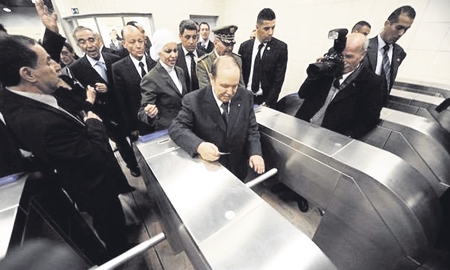In terms of territory Algeria is the largest country in Africa, covering some 2,381,740 square kilometres, four-fifths of which are desert. Aircraft and railways have an important contribution to make to its transportation network, while its 1,000-kilometre (621-mile) Mediterranean coastline offers opportunities to trade by sea with potential to be more fully exploited.
The country has seen a big increase in air travel and airfreight – trends that are expected to grow as the economy expands. Fourteen new airports will be built, raising the number of airports in the country to around 70.
Algeria has four major airports, located in Algiers, Oran, Annaba and Constantine, of which Houari Boumediene International is the busiest, handling more than 7 million passengers per year.
Faced with increasing competition from foreign operators, the national carrier, Air Algerie, has enlarged its fleet and is expanding its international flight network. Its aim is to increase passenger numbers to 6 million by 2014, from 3 million in 2009.
Approximately 90 per cent of Algeria’s commercial trade – including oil and gas exports – passes through the country’s ten commercial ports. All man-made – Algeria’s coastline has no natural harbours – they include the ports of Algiers, Oran, Bejaia, Annaba, Arzew and Skikda. Four new ports are planned in the current phase of infrastructure development. New harbours in Algiers and Tenes will reduce the pressure on the capital’s port, which handles more than half the country’s container traffic. Funds are also being allocated to rehabilitate existing ports, among them 20 fishing ports. A number of ports, including Oran, Mostaganem, Tenes, Skikda and Djen Djen, are to be connected via new motorway links to the new East-West Highway.
Meanwhile, some $1.5 billion (£960 million) is to be invested in modernising and expanding Algeria’s 4,000-kilometre rail network, which is mainly used to transport cargo.
Anesrif, the national agency for the planning and implementation of railway investments, plans to expand the network to 10,600 kilometres by 2016, thus establishing railway connectivity to the high plateau region.
Around 630 kilometres of new lines will connect Boughezoul to M’Sila, Relizane to Tissemsilt via Tiaret, Saida to Tiaret and Tissemsilt to Boughezoul. Other railway projects include a line from Tlemcen to the Moroccan border at Akid Abbas and a southern loop line, connecting Hassi Messaoud, Ouargla, Ghardaia, Laghouat and Djelfa.
A budget of $2 billion has been set aside for the purchase of long-distance trains and a railcar manufacturing plant is to be established in Annaba as a joint venture between French group Alstom and the Algerian state-run company Ferrovial.
Life has improved for commuters in Algiers with the inauguration by President Bouteflika last October of the long-awaited metro line.
Built over five years by a consortium comprising Siemens France, VINCI Construction Grands Projets and CAF, the first segment of Line 1 of the capital’s undergroun system includes ten stations covering nine kilometres.

0 COMMENTS